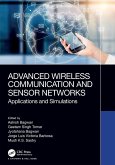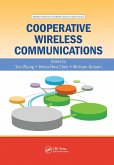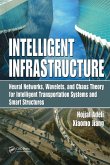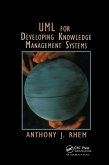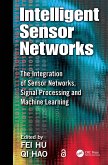Deep Learning for Internet of Things Infrastructure
Herausgeber: Ghosh, Uttam; Pathan, Al-Sakib Khan; Kashif Bashir, Ali; Alazab, Mamoun
Deep Learning for Internet of Things Infrastructure
Herausgeber: Ghosh, Uttam; Pathan, Al-Sakib Khan; Kashif Bashir, Ali; Alazab, Mamoun
- Broschiertes Buch
- Merkliste
- Auf die Merkliste
- Bewerten Bewerten
- Teilen
- Produkt teilen
- Produkterinnerung
- Produkterinnerung
This book promotes and facilitates exchanges of research knowledge and findings across different disciplines on the design and investigation of deep learning (DL)-based data analytics of IoT (Internet of Things) infrastructures.
Andere Kunden interessierten sich auch für
![The Internet of Things The Internet of Things]() The Internet of Things80,99 €
The Internet of Things80,99 €![Advanced Wireless Communication and Sensor Networks Advanced Wireless Communication and Sensor Networks]() Advanced Wireless Communication and Sensor Networks66,99 €
Advanced Wireless Communication and Sensor Networks66,99 €![Cooperative Wireless Communications Cooperative Wireless Communications]() Cooperative Wireless Communications80,99 €
Cooperative Wireless Communications80,99 €![Intelligent Infrastructure Intelligent Infrastructure]() Hojjat AdeliIntelligent Infrastructure91,99 €
Hojjat AdeliIntelligent Infrastructure91,99 €![UML for Developing Knowledge Management Systems UML for Developing Knowledge Management Systems]() Anthony J RhemUML for Developing Knowledge Management Systems80,99 €
Anthony J RhemUML for Developing Knowledge Management Systems80,99 €![3D Television (3DTV) Technology, Systems, and Deployment 3D Television (3DTV) Technology, Systems, and Deployment]() Daniel Minoli3D Television (3DTV) Technology, Systems, and Deployment116,99 €
Daniel Minoli3D Television (3DTV) Technology, Systems, and Deployment116,99 €![Intelligent Sensor Networks Intelligent Sensor Networks]() Intelligent Sensor Networks80,99 €
Intelligent Sensor Networks80,99 €-
-
-
This book promotes and facilitates exchanges of research knowledge and findings across different disciplines on the design and investigation of deep learning (DL)-based data analytics of IoT (Internet of Things) infrastructures.
Hinweis: Dieser Artikel kann nur an eine deutsche Lieferadresse ausgeliefert werden.
Hinweis: Dieser Artikel kann nur an eine deutsche Lieferadresse ausgeliefert werden.
Produktdetails
- Produktdetails
- Verlag: CRC Press
- Seitenzahl: 248
- Erscheinungstermin: 7. Oktober 2024
- Englisch
- Abmessung: 234mm x 156mm x 14mm
- Gewicht: 381g
- ISBN-13: 9781032064703
- ISBN-10: 1032064706
- Artikelnr.: 71693310
- Herstellerkennzeichnung
- Libri GmbH
- Europaallee 1
- 36244 Bad Hersfeld
- gpsr@libri.de
- Verlag: CRC Press
- Seitenzahl: 248
- Erscheinungstermin: 7. Oktober 2024
- Englisch
- Abmessung: 234mm x 156mm x 14mm
- Gewicht: 381g
- ISBN-13: 9781032064703
- ISBN-10: 1032064706
- Artikelnr.: 71693310
- Herstellerkennzeichnung
- Libri GmbH
- Europaallee 1
- 36244 Bad Hersfeld
- gpsr@libri.de
Uttam Ghosh is working as an Assistant Professor of the Practice in the Department of Electrical Engineering and Computer Science, Vanderbilt University, Nashville, TN, USA. Dr. Ghosh obtained his PhD in Electronics and Electrical Engineering from the Indian Institute of Technology Kharagpur, India in 2013, and has Post-doctoral experience at the University of Illinois in Urbana-Champaign, Fordham University, and Tennessee State University. He has been awarded the 2018-2019 Junior Faculty Teaching Fellow (JFTF) and has been promoted to a Graduate Faculty position at Vanderbilt University. Dr. Ghosh has published fifty papers at reputed international journals including IEEE Transaction, Elsevier, Springer, IET, Wiley, InderScience and IETE, and also in top international conferences sponsored by IEEE, ACM, and Springer. Dr. Ghosh has conducted several sessions and workshops related to Cyber-Physical Systems (CPS), SDN, IoT and smart cities as co-chair at top international conferences including IEEE Globecom, IEEE MASS, SECON, CPSCOM, IEMCON, ICDCS and so on. He has served as a Technical Program Committee (TPC) member at renowned international conferences including ACM SIGCSE, IEEE LCN, IEMCON, STPSA, SCS SpringSim, IEEE Compsac. He is serving as an Associate Editor of the International Journal of Computers and Applications, Taylor & Francis, and also a reviewer for international journals including IEEE Transactions, Elsevier, Springer and Wiley. Dr. Ghosh is contributing as guest editor for special issues with IEEE Transaction on Industrial Informatics (TII), IEEE Journal of IoT, IEEE Transaction on Network Science and Engineering (TNSE), ACM Transactions on Internet ten edited volumes on Emerging CPS, Security, Machine / Machine Learning with CRC Press, Chapman Hall Big Data Series and Springer. His main research interests include Cybersecurity, Computer Networks, Wireless Networks, Information Centric Networking and Software-Defined Networking. Ali Kashif Bashir is a Senior Lecturer/Associate Professor and Program Leader of BSc (H) Computer Forensics and Security at the Department of Computing and Mathematics, Manchester Metropolitan University, United Kingdom. He also enjoys honorary positions: Honorary Professor and Chief Advisor of Visual Intelligence Research Center, School of Information and Communication Engineering, University of Electronics Science and Technology of China (UESTC), China; and Adjunct Professor of School of Electrical Engineering and Computer Science, National University of Science and Technology (NUST), Islamabad, Pakistan. His past assignments include Associate Professor of ICT, University of the Faroe Islands, Denmark; Osaka University, Japan; Nara National College of Technology, Japan; the National Fusion Research Institute, South Korea; Southern Power Company Ltd., South Korea, and the Seoul Metropolitan Government, South Korea. He received his Ph.D. in computer science and engineering from Korea University South Korea. He is a senior member of IEEE, member of IEEE Industrial Electronic Society, member of ACM, and Distinguished Speaker of ACM. He has authored over 150 research articles; received funding as PI and Co-PI from research bodies of South Korea, Japan, EU, UK and Middle East; supervising/co-supervising several graduate (MS and PhD) students. His research interests include internet of things, wireless networks, distributed systems, network/cyber security, network function virtualization, machine learning, etc. He is serving as the Editor-in-chief of the IEEE FUTURE DIRECTIONS NEWSLETTER. He is also serving as area editor of KSII Transactions on Internet and Information Systems; associate editor of IEEE Internet of Things Magazine, IEEE Access, IET Quantum Computing, Journal of Plant Disease and Protection. He has also organized 24 Guest Editorials in the top Journals of IEEE, Elsevier, Springer and Elsevier. He has delivered 20 + invited/keynote talks. He is leading many conferences as a chair (program, publicity, and track) and had organized workshops in flagship conferences like IEEE Infocom, IEEE Globecom, IEEE Mobicom, etc. Mamoun Alazab received his PhD degree in Computer Science from the Federation University of Australia, School of Science, Information Technology and Engineering. He is currently an Associate Professor in the College of Engineering, IT and Environment at Charles Darwin University, Australia. He is a cyber-security researcher and practitioner with industry and academic experience. Dr. Alazab's research is multidisciplinary, with a focus on cyber security and digital forensics of computer systems, including current and emerging issues in the cyber environment, such as cyber-physical systems and the Internet of Things. His research takes into consideration the unique challenges present in these environments, with an emphasis on cybercrime detection and prevention. He has a particular interest in the application of machine learning as an essential tool for cybersecurity, examples of which include detecting attacks, analyzing malicious code, and uncovering vulnerabilities in software. He is the Founder and the Chair of the IEEE Northern Territory Subsection (February 2019 - present), a Senior Member of the IEEE, and a Member of the IEEE Computer Society's Technical Committee on Security and Privacy (TCSP). In addition, he has collaborated with government and industry on many projects, including work with IBM, Trend Micro, Westpac, the Australian Federal Police (AFP), the Australian Communications. Al-Sakib Khan Pathan is a Professor of Computer Science and Engineering. Currently, he is with the Independent University, Bangladesh as an Adjunct Professor. He received PhD degree in Computer Engineering in 2009 from Kyung Hee University, South Korea and B.Sc. degree in Computer Science and Information Technology from Islamic University of Technology (IUT), Bangladesh in 2003. In his academic career so far, he worked as a faculty member at the CSE Department of Southeast University, Bangladesh during 2015-2020, Computer Science department, International Islamic University Malaysia (IIUM), Malaysia during 2010-2015; at BRACU, Bangladesh during 2009-2010, and at NSU, Bangladesh during 2004-2005. He was a Guest Lecturer for the STEP project at the Department of Technical and Vocational Education, Islamic University of Technology, Bangladesh in 2018. He also worked as a Researcher at Networking Lab, Kyung Hee University, South Korea from September 2005 to August 2009 where he completed his MS leading to PhD. His research interests include wireless sensor networks, network security, cloud computing, and e-services technologies. Currently he is also working on some multidisciplinary issues. He is a recipient of several awards/best paper awards and has several notable publications in these areas. So far, he has delivered over 22 Keynotes and Invited speeches at various international conferences and events. He has served as a General Chair, Organizing Committee Member, and Technical Program Committee (TPC) member in numerous top-ranked international conferences/workshops like INFOCOM, GLOBECOM, ICC, LCN, GreenCom, AINA, WCNC, HPCS, ICA3PP, IWCMC, VTC, HPCC, SGIoT, etc. He was awarded the IEEE Outstanding Leadership Award for his role in IEEE GreenCom'13 conference and Outstanding Service Award in recognition for the service and contribution to the IEEE 21st IRI 2020 conference. He is currently serving as the Editor-in-Chief of International Journal of Computers and Applications, Taylor & Francis, UK, Editor of Ad Hoc and Sensor Wireless Networks, Old City Publishing, International Journal of Sensor Networks, Inderscience Publishers, and Malaysian Journal of Computer Science, Associate Editor of Connection Science, Taylor & Francis, UK, International Journal of Computational Science and Engineering, Inderscience, Area Editor of International Journal of Communication Networks and Information Security, Guest Editor of many special issues of top-ranked journals, and Editor/Author of 22 books. One of his books has been included twice in Intel Corporation's Recommended Reading List for Developers, 2nd half 2013 and 1st half of 2014; 3 books were included in IEEE Communications Society's (IEEE ComSoc) Best Readings in Communications and Information Systems Security, 2013, several other books were indexed with all the titles (chapters) in Elsevier's acclaimed abstract and citation database, Scopus, in February 2015, at least one has been approved as a textbook at NJCU, USA in 2020, and one book has been translated to simplified Chinese language from English version. Also, 2 of his journal papers and 1 conference paper were included under different categories in IEEE Communications Society's (IEEE ComSoc) Best Readings Topics on Communications and Information Systems Security, 2013. He also serves as a referee of many prestigious journals. He received some awards for his reviewing activities like: one of the most active reviewers of IAJIT several times; Elsevier Outstanding Reviewer for Computer Networks, Ad Hoc Networks, FGCS, and JNCA in multiple years. He is a Senior Member of the Institute of Electrical and Electronics Engineers (IEEE), USA.d Media Authority (ACMA), Westpac, UNODC to name a few.
1. Data Caching at Fog Nodes under IoT Networks: Review of Machine Learning
Approaches 2. ECC-Based Privacy-Preserving Mechanisms Using Deep Learning
for Industrial IoT: A State-of-the-Art Approaches 3. Contemporary
Developments and Technologies in Deep Learning-Based IoT 4. Deep
Learning-Assisted Vehicle Counting for Intersection and Traffic Management
in Smart Cities 5. Toward Rapid Development and Deployment of Machine
Learning Pipelines across Cloud-Edge 6. Category Identification Technique
by a Semantic Feature Generation Algorithm 7. Role of Deep Learning
Algorithms in Securing Internet of Things Applications 8. Deep Learning and
IoT in Ophthalmology 9. Deep Learning in IoT-Based Healthcare Applications
10. Authentication and Access Control for IoT Devices and Its Applications
11. Deep Neural Network-Based Security Model for IoT Device Network
Approaches 2. ECC-Based Privacy-Preserving Mechanisms Using Deep Learning
for Industrial IoT: A State-of-the-Art Approaches 3. Contemporary
Developments and Technologies in Deep Learning-Based IoT 4. Deep
Learning-Assisted Vehicle Counting for Intersection and Traffic Management
in Smart Cities 5. Toward Rapid Development and Deployment of Machine
Learning Pipelines across Cloud-Edge 6. Category Identification Technique
by a Semantic Feature Generation Algorithm 7. Role of Deep Learning
Algorithms in Securing Internet of Things Applications 8. Deep Learning and
IoT in Ophthalmology 9. Deep Learning in IoT-Based Healthcare Applications
10. Authentication and Access Control for IoT Devices and Its Applications
11. Deep Neural Network-Based Security Model for IoT Device Network
1. Data Caching at Fog Nodes under IoT Networks: Review of Machine Learning
Approaches 2. ECC-Based Privacy-Preserving Mechanisms Using Deep Learning
for Industrial IoT: A State-of-the-Art Approaches 3. Contemporary
Developments and Technologies in Deep Learning-Based IoT 4. Deep
Learning-Assisted Vehicle Counting for Intersection and Traffic Management
in Smart Cities 5. Toward Rapid Development and Deployment of Machine
Learning Pipelines across Cloud-Edge 6. Category Identification Technique
by a Semantic Feature Generation Algorithm 7. Role of Deep Learning
Algorithms in Securing Internet of Things Applications 8. Deep Learning and
IoT in Ophthalmology 9. Deep Learning in IoT-Based Healthcare Applications
10. Authentication and Access Control for IoT Devices and Its Applications
11. Deep Neural Network-Based Security Model for IoT Device Network
Approaches 2. ECC-Based Privacy-Preserving Mechanisms Using Deep Learning
for Industrial IoT: A State-of-the-Art Approaches 3. Contemporary
Developments and Technologies in Deep Learning-Based IoT 4. Deep
Learning-Assisted Vehicle Counting for Intersection and Traffic Management
in Smart Cities 5. Toward Rapid Development and Deployment of Machine
Learning Pipelines across Cloud-Edge 6. Category Identification Technique
by a Semantic Feature Generation Algorithm 7. Role of Deep Learning
Algorithms in Securing Internet of Things Applications 8. Deep Learning and
IoT in Ophthalmology 9. Deep Learning in IoT-Based Healthcare Applications
10. Authentication and Access Control for IoT Devices and Its Applications
11. Deep Neural Network-Based Security Model for IoT Device Network



